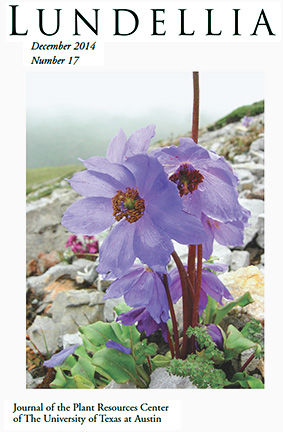
Journal of the Plant Resources Center of the University of Texas at Austin
Number 17 — December 2014
[Published: 11 December 2014]
Contents:
A New Species of
Roldana (Asteraceae) from Huehuetenango, Guatemala
Taylor Sultan Quedensley, Mario Esteban Véliz Pérez, & Luis Eduardo Velázquez Méndez
View Abstract — Download article (28 MB)
The Role of Allotriploidy in the Evolution of
Meconopsis (Papaveraceae): A Preliminary Study of Ancient Polyploidy and Hybrid Speciation
Wei Xiao & Beryl B. Simpson
View Abstract — Download article (29.9 MB)
Abstracts
A New Species of Roldana (Asteraceae) from Huehuetenango, Guatemala
Taylor Sultan Quedensley, Mario Esteban Véliz Pérez, & Luis Eduardo Velázquez Méndez
1—4
Abstract: Roldana riparia is described from Huehuetenango, Guatemala (Municipio de Chiantla). The genus Roldana is abundant in montane forests of Guatemala (nine species) and the new species is endemic to the Sierra Cuchumatanes.
Resumen: Se describe Roldana riparia como especie nueva de Huehuetenango, Guatemala (Municipio de Chiantla). El género Roldana
es abundante en los bosques montañosos de Guatemala, con nueve especies, y la especie nueva es endémica de la Sierra Cuchumatanes.
Return to Vol. 17 Contents
The Role of Allotriploidy in the Evolution of Meconopsis (Papaveraceae): A Preliminary Study of Ancient Polyploidy and Hybrid Speciation
Wei Xiao & Beryl B. Simpson
5—17
Abstract: Also known as the Himalayan Poppy, Meconopsis is a genus of herbaceous plants growing only in the high elevation habits of the Himalaya and its adjacent plateau and mountain areas. The genus exhibits high morphological and ecological diversity, but the major causes of divergence in Meconopsis have not previously been studied. Our recent revised taxonomic classification, based on a molecular phylogeny, divided the genus into four monophyletic sections. Because chromosome number varies among these sections and our previous phylogenetic analyses revealed extensive incongruence between the recovered nrITS and cpDNA trees, possibly due to ancient hybridization, this study focused on evaluating the potential role of ancient polyploidization and hybridization in Meconopsis’ evolutionary history. Our investigation based on the results of reconstructed ancestral chromosome numbers using a Maximum Likelihood method implemented in chromEvol showed that two extant Meconopsis sections (sect. Grandes and sect. Primulinae) shared a triploid ancestor. We further examined the pattern of hybridization in Meconopsis by reconstructing a nuclear marker GAPDH (glyceraldehyde 3-phosphate dehydrogenase gene) network. The result, along with morphological, phylogenetic, and cytological evidence, all point to a hybrid nature of the triploid ancestor. Based on the resultant GAPDH network, an ancient reticulate evolution scenario in Meconopsis is proposed. Overall, this preliminary study shows how an ancient triploid event promoted polyploid evolution in Meconopsis and also exemplifies how allotriploidization and successive polyploidization played an important role in diversification of the genus.
Return to Vol. 17 Contents
A New Species of Mortoniodendron (Malvaceae sens. lat.) from Chiapas, Mexico
Mario Ishiki & Tom Wendt
18—23
Abstract: The new species Mortoniodendron ocotense is described from northwestern Chiapas, Mexico, where it is a locally abundant tree on karst substrates in seasonal evergreen rain forest. It falls within a group with five previously described species, of which the most closely related is M. uxpanapense. A simplified key to the six species is presented.
Resumen: Se describe la especie nueva arbórea de Mortoniodendron ocotense del noroeste de Chiapas, México, localmente abundante sobre substratos cársticos en selva mediana perennifolia. Pertenece a un grupo formado por cinco especies anteriormente descritas más la nueva, de las cuáles M. uxpanapense parece ser la especie más emparentada. Se presenta una clave para la identificacián de las seis especies.
Return to Vol. 17 Contents
Overview of Vicia (Fabaceae) of Mexico
Billie L. Turner
24—31
Abstract: Vicia has 12 species in Mexico; 4 of the 12 are introduced. Two new names are proposed: Vicia mullerana B.L. Turner, nom. & stat. nov., (based on V. americana subsp. mexicana C.R. Gunn, non V. mexicana Hemsl.), and V. ludoviciana var. occidentalis (Shinners) B.L. Turner, based on V. occidentalis Shinners, comb. nov. Vicia pulchella Kunth subsp. mexicana (Hemsley) C.R. Gunn is better treated as V. sessei G. Don, the earliest name at the specific level. A key to the taxa is provided along with comments upon species relationships, and maps showing distributions.
Return to Vol. 17 Contents
 Lundellia Home Page
Lundellia Home Page
U. Texas at Austin | Biological
Sciences | Plant Resources Center | Contact Us

